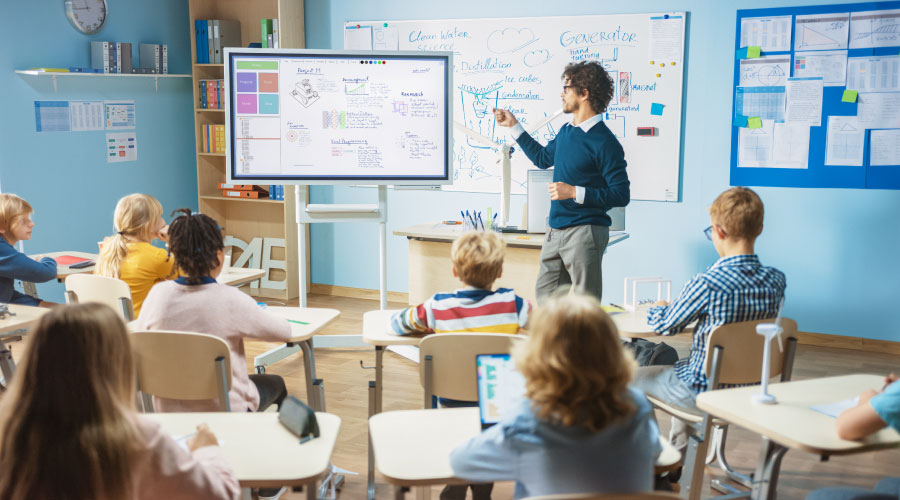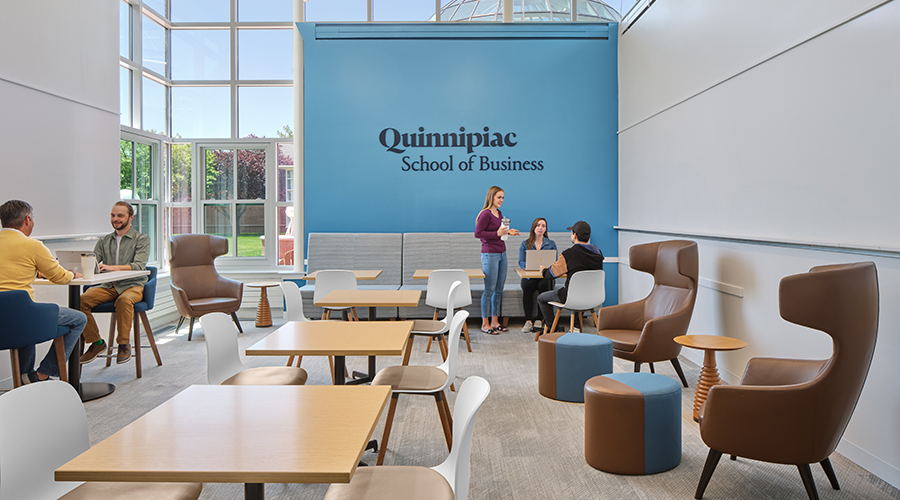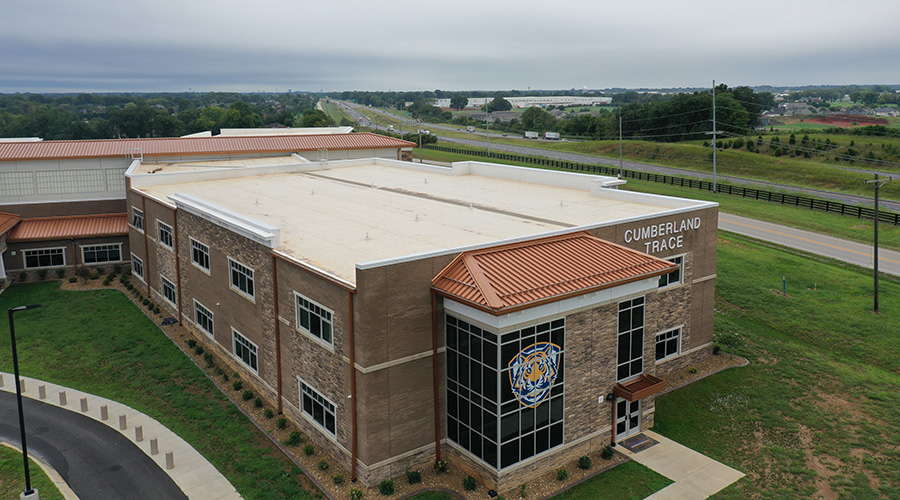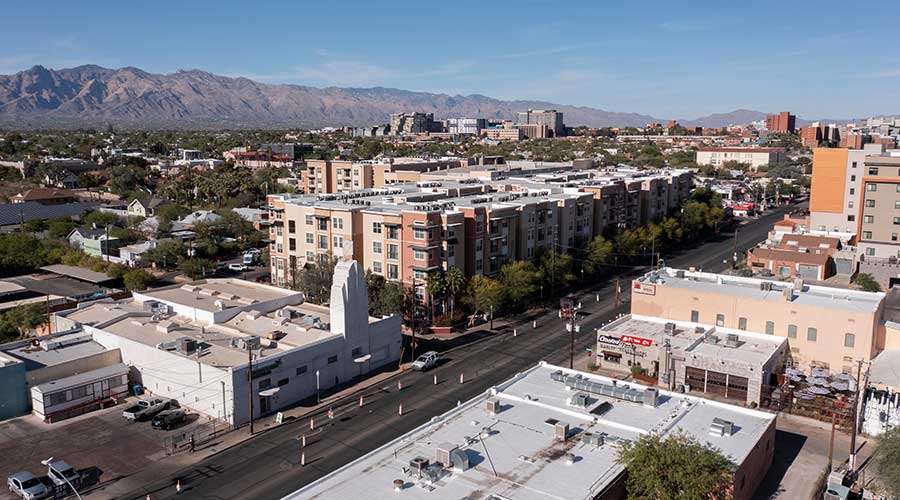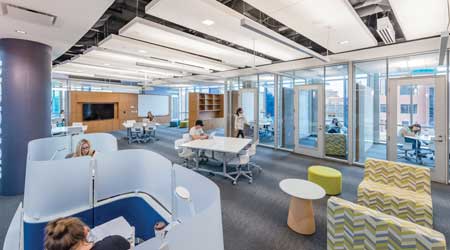 The Wond’ry at Vanderbilt University is a 13,000-square-foot campus resource dedicated to fostering an innovative and entrepreneurial culture.© Anton Grassl Photography
The Wond’ry at Vanderbilt University is a 13,000-square-foot campus resource dedicated to fostering an innovative and entrepreneurial culture.© Anton Grassl Photography3 Higher Ed Facility Strategies to Improve Collaboration
Facility managers should respond to the trend toward collaboration by providing maker-spaces, tiered classrooms, and a range of community and informal meeting spaces.
Today’s academic institutions are facing a shift in both enrollment and academic structure. With a decreasing college-bound population and the rise of online courses and degrees, higher education communities are facing urgent pressure to reimagine their institutions. We see such responses in a variety of ways, from widening criteria for acceptance to remodeling spaces to be more conducive to collaboration and wellness. By investing in design to impact occupant experiences positively, these institutions can see growth in student learning as well as student and faculty recruitment and retention, curbing the liability of attrition.
When drafting design plans, there are a handful of principles and practices that will help promote a more positive experience.
The collaborative component
Once a rather individualistic setting, higher education — particularly STEM programs — have embraced a more collaborative approach to learning curriculum and spaces. Students learn faster and with greater retention working with their colleagues as opposed to independently. With environments like maker-spaces, tiered classrooms, and various types of flexible informal spaces, students and faculty have options for greater connection to facilitate problem-based learning.
This approach is supported by the trend for corporations to focus on a workforce accustomed to group settings, reflecting their culture of building community and partnership. For example, Google, which historically ranks highly in Fortune’s 100 Best Companies to Work For, provides environments that encourage casual collisions, promote employee engagement, and reinforce an open culture.
1. Maker-spaces. More and more, maker-space is becoming a staple in higher education institutions. Designed as a creative environment that brings students together, this type of setting engages students in hands-on learning and promotes group activities. Whether high-tech, low-tech, or no-tech, students can explore ideas with tools and materials, in a productive setting ideal for innovation and creativity.
The Digital Media Commons project at Northeastern University transformed 100,000 square feet of the Snell Library from traditional book stack space to a flexible learning commons with state-of-the-art media capabilities. As an innovative model that supports collaboration in digital creation, design, and analysis, the Digital Media Commons reaches beyond the traditional library mission to include resources as diverse as 3D printing labs, an innovation center, and audio/video/post-production studios. The strategic ground floor location now includes one of the signature spaces of the project — a dramatic 10,000-square-foot open plan commons. Students have the option to work independently or in small teams. Thirty media-capable collaborative rooms provide the tools and setting for students, faculty, and researchers to create and share content.
2. Tiered classrooms. Once littered with large auditoriums and lecture halls, campuses are now looking to leverage these spaces to accommodate varying pedagogies. Transitioning from the antiquated model of the “sage-on-the-stage” to a multi-purpose tiered classroom provides both a traditional lecture style setting and a group work format. Each tier, with two rows of moveable seating and a wide table between, allows for a different format in which a lecture can be combined with breakouts for small group work.
3. Range of community and informal learning spaces. In learning, one size does not fit all. Providing a variety of environments encourages and supports collaboration. Students now experience spaces that allow for a range of postures like high-top and standing configurations and casual layouts reminiscent of living rooms, as well as traditional desk and table areas. Not all students learn the same way and having a choice in one’s setting can make a difference in an individual’s comfort level and participation.
The Wond’ry at Vanderbilt University is a 13,000-gross-square-foot campus resource dedicated to fostering an innovative and entrepreneurial culture. With programs that include a speaker series, hackathons, networking events, and the Innovation Garage — for testing disruptive technologies — the Wond’ry works with diverse resources to accelerate the transfer of laboratory discoveries and academic-based concepts to the marketplace. As host of the PreFlight/PostFlight programs, the Wond’ry provides student for-profit and non-profit venture ideas with entrepreneurial support. Features of the three-story space include co-labs, teaming rooms, media presentation lounge, and maker-spaces for 3D printing, foam fabrication, rapid prototyping, and robotics. On-site staffing, training, and mentoring support leverage these technologies. The Wond’ry draws on its adjacency to the new 235,000-gross-square-foot Engineering and Science Building, which expands interdisciplinary research in biomedical engineering, energy, and materials science.
David Feth (DFeth@HGA.com), AIA, LEED AP, principal with Wilson HGA in Boston, has specialized in the design of teaching and research environments for higher education clients. He has led the design of numerous STEM (science, technology, engineering, and math) spaces.
Related Topics:











